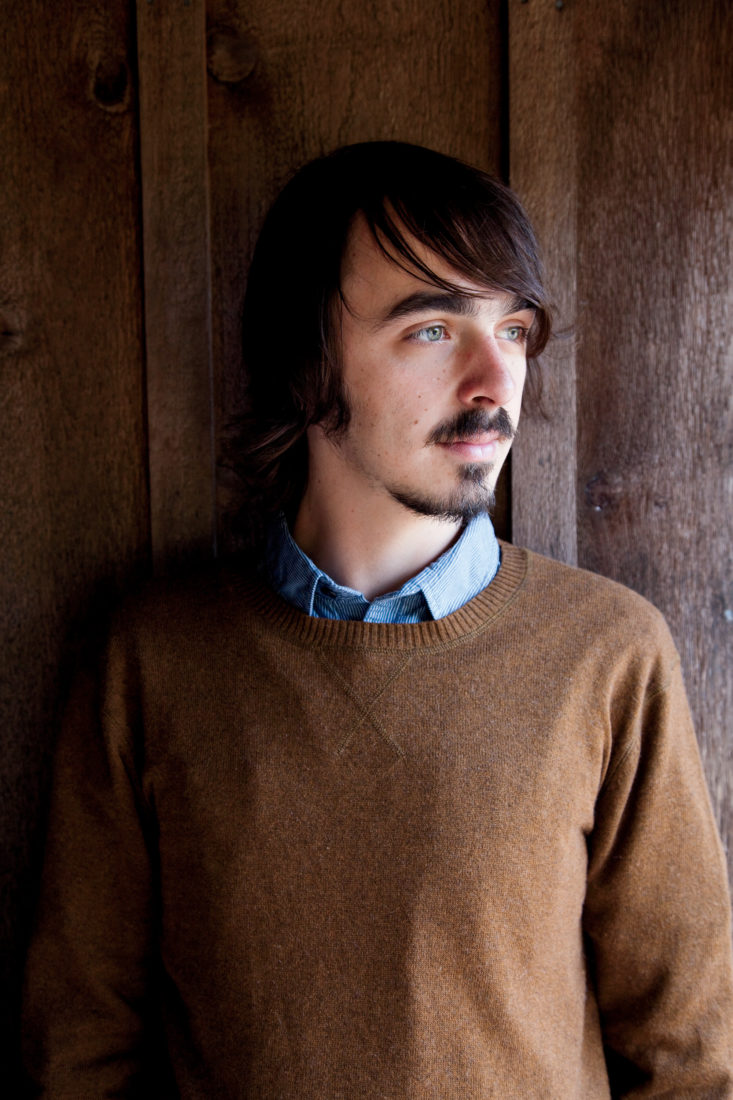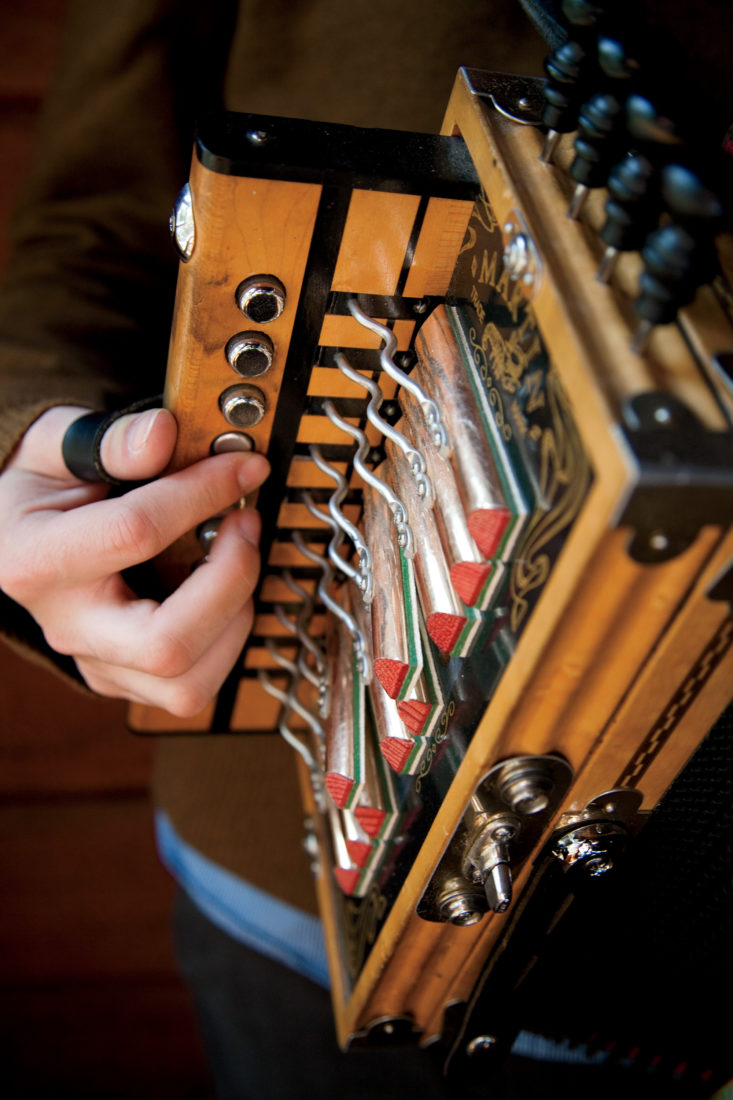From outside, the Blue Moon Saloon, just off the long stretch of highway between New Orleans and Houston, in Lafayette, Louisiana, looks like any other roadhouse. You can see some string lights out front. Some people mill about; others play accordions on the porch.
But the music coming from the back sounds different from what’s on the porch. You can hear the bass from the road. On this Saturday night, the rough enclosure that is the performance space is packed. The band onstage is Feufollet. They’re playing “Au Fond du Lac,” a mesmerizing, dark song written by lead singer Anna Laura Edmiston about a lover trapped at the bottom of a lake. It’s hard and fast. You can dance to it.

Photo: Cedric Angeles
Anna Laura Edmiston
You can see the sky through a hole in the roof and the audience in a Pabst Blue Ribbon mirror on the wall. At the front, they’re doing an indie rock shuffle, and a little bit farther back some are trying their best to do Cajun swing in the tight crowd. At the bar, chatter is equal parts English and French. This is where Cajun culture lives.
At center stage is vocalist and multi-instrumentalist Chris Stafford, who at twenty-four is a young Cajun blossoming into rock band frontmanhood: black hair starting to flop over his eyes, beard just coming in to form a seventies goatee. He’s been performing for nearly two decades, but he maintains a sparkle-eyed surprise at the mere presence of an audience. “Everyone clap your hands on this beat!” he says, clapping out a little rhythm. “At this part, say ‘Ca-jun!’”
“Ca-jun!”

Photo: Cedric Angeles
Chris Stafford
Feufollet started as a child prodigy band, rocking dance halls with traditional Cajun two-steps and waltzes even when the members were still preteens. (“Feufollet” translates to “crazy fire” and refers to the burning swamp gases that dance over the trees at night.) As they’ve grown up, their signature blends of rock, country, and Cajun have made them one of the most progressive bands in the crackling scene of young Cajun musicians swirling around Lafayette.
They played a set earlier in the day as well, at Lafayette’s Festivals Acadiens et Créoles, a regional celebration of everything Cajun, from music to food, crafts, and the French language. But there’s a different kind of Cajun on display at the Blue Moon tonight. It’s wilder and it’s rougher, and it’s seething with momentum. Onstage, Stafford and Chris Segura are sawing at twin fiddles in the chorus. “Le ciel était si beau avant que tu emmènes la pluie, Mais on s’habitue à être inondé,” sings Edmiston, swampy sweet in sundress and cowboy boots.
Feufollet is the most distinctive band of a thriving young Cajun crowd that’s been bubbling since the early 2000s. The button accordion and the fiddle remain the centerpieces, but glockenspiels, electric guitars, and synthesizers give them a sound that feels more like it belongs somewhere halfway between an indie rock club in Brooklyn and a Louisiana swamp—ecce Blue Moon. They call Stafford the Little Cajun Stevie Wonder. He plays everything but drums, but recently he’s been spending less time with his Lafayette-made accordion and more with his deep blue Fender Telecaster.
Acadiana has always had a rock-and-roll swagger, and not just from the relentless in-and-out rhythm of the button accordion. There’s an ironclad confidence evident in a people who even after the railroad, the Civil War, I-10, and Hollywood still stick to a quixotic culture so particular that the rest of the country requires literal translation to understand it. A woman once told me that more than a century and a half after the region’s supposed incorporation into the United States, her mother still told her not to trust “les Américains.”
Photo: Cedric Angeles
Philippe Billeaudeaux (bass)
1 of 4
Photo: Cedric Angeles
Michael Stafford (drums)
2 of 4
Photo: Cedric Angeles
Chris Segura (fiddle)
3 of 4
Photo: Cedric Angeles
Andrew Toups (keyboard)
4 of 4
Twenty years ago the staunchest defenders of francophone Louisiana would’ve been old men playing ancient tunes with religious tenacity. But those acts are getting rarer—and when the younger generation took that torch, they poured gasoline on it. By the early 2000s, as Feufollet were being touted as young wonders, other bands like the Pine Leaf Boys, the Red Stick Ramblers, and the Lost Bayou Ramblers were all coming onto the scene with long-absent young blood.
There’s an old saying that Lafayette has a hundred bands but only ten musicians, and it’s still true. The clubs are electric with musicians; the scene feeds itself. People play in each other’s bands and on each other’s albums; some bands exist for only one show. “It’s like Laurel Canyon in the sixties with people like Joni Mitchell, Jim Morrison, and Neil Young,” says Feufollet bassist Philippe Billeaudeaux. “That’s what we’ve got going on here in Lafayette.”
The French language is what binds their music. Stafford and his brother, drummer Michael, took classes starting in elementary school; Billeaudeaux and singer Edmiston grew up speaking it. It didn’t take long for Feufollet to become a household name on the Lafayette Cajun scene. They held the biggest spot at the Festivals Acadiens et Créole this year, where the announcer proudly called them “the most innovative band in Cajun music, period.”
But their recordings have been reaching further. Their 2008 release, Cow Island Hop, received glowing praise from NPR’s All Things Considered. Last February the New York Times called them “downright radical in the studio.” Elvis Costello called their most recent album, En Couleurs, “one of the most beautifully melodic records I’ve heard all year.” It got them a Grammy nomination.
On the national scale, high praise is reserved for innovation. But some in the Cajun music sphere have had a hard time adjusting to the new generation. Billeaudeaux likes to tell a story about a festival they played in California. His brother came to the show, they got to drinking, and they got to fighting. Some other frightened musicians tried to get the organizers to call security. “Are you kidding?” one of them said. “We don’t have any security—this is an accordion festival!”

Photo: Cedric Angeles
The band at Dockside Studio in Maurice, Louisiana
Back at the Blue Moon, a dancer with a light beard is slumping into the shoulder of a girl with black hair and red pants. “Vous êtes la raison,” he whispers in her ear. “Vous êtes la raison.” Feufollet is finishing up their set with “Boozoo’s Theme Song,” a zydeco tune with enough of an edge to complement the chill in the October air coming in through the slats in the tin roof. “That’s it!” Stafford says to an audience demanding another encore. “We are not playing any more.”
As the band packs up, some fans are hanging around the porch and chatting with Billeaudeaux. Others are heading across the street to see Joel Savoy with Jesse Lége at the Artmosphere. Lége is an old-school accordionist—that means he plays four-hour sets with no breaks. And he’s incomprehensible when he speaks English.
Red Stick Ramblers guitarist Chas Justus is outside, his shirt unbuttoned down to his navel. “There are people with a disdain for popular culture—it was the same with punk music, the same with old-time, and the same with this Cajun thing,” he says. “That’s the great thing about French music—it’s in French, and the American public will never buy it. It’s a holdout.”
Feufollet isn’t quite so fatalistic about their music. But they know that English sells—another Lafayette band, the Givers, have become MTV darlings with a more traditional pop sound. “We’ll play some English tunes, but we’re not going to turn into a band that sings all in English,” Segura says. “French is what brought us together.”
Still, there’s no language barrier in the rhythm, and acts like the Lost Bayou Ramblers are making it stick in the rest of the country. Feufollet has already gotten more national attention than most, but they’re playing their cards a little closer to the chest, eyeing that bigger stage with caution even as they gather all the weapons they need to take it. As is sometimes the way with the Cajuns, the biggest question for Feufollet’s conquering the rest of the country might be whether or not they want to have anything to do with the rest of the country.












